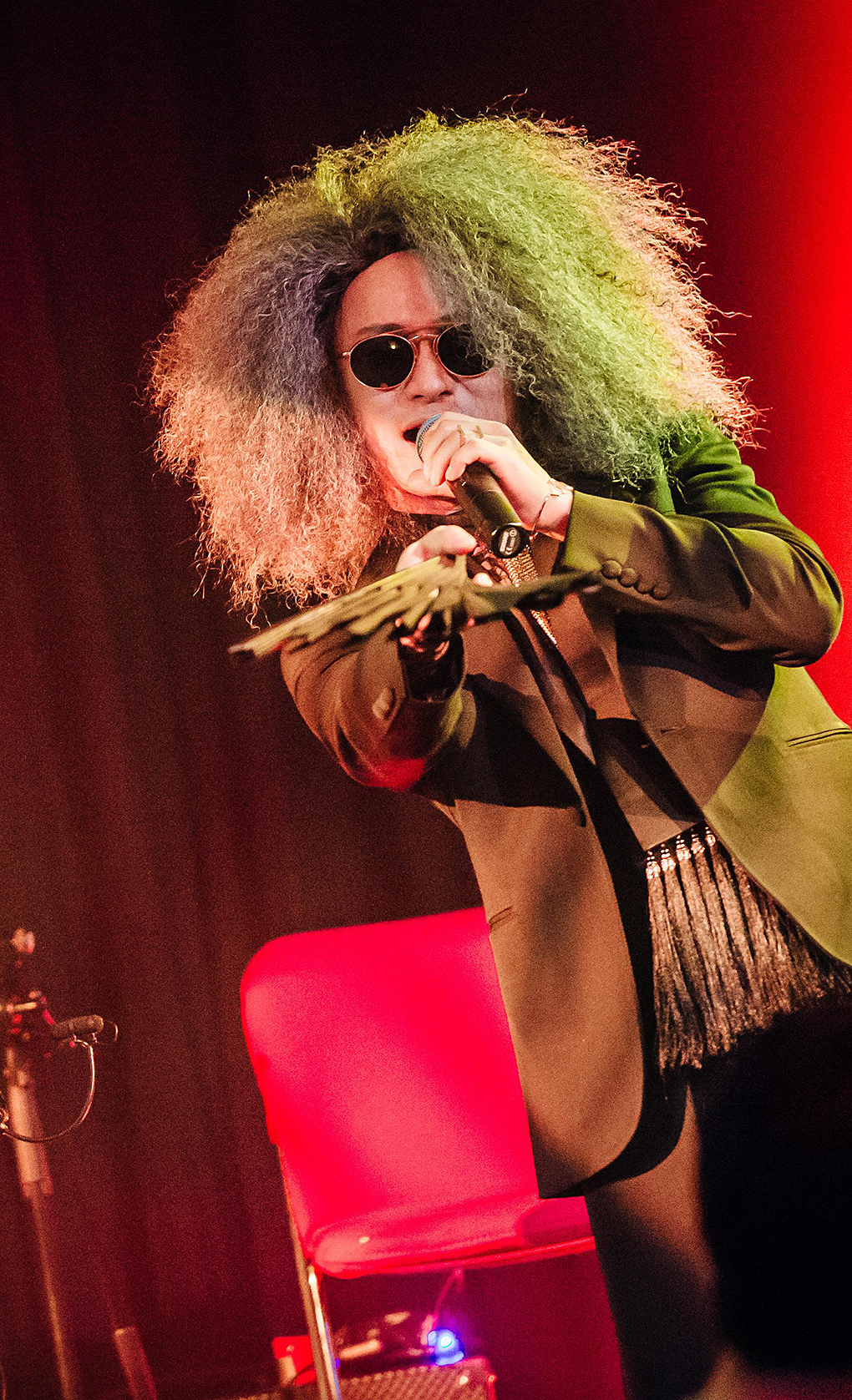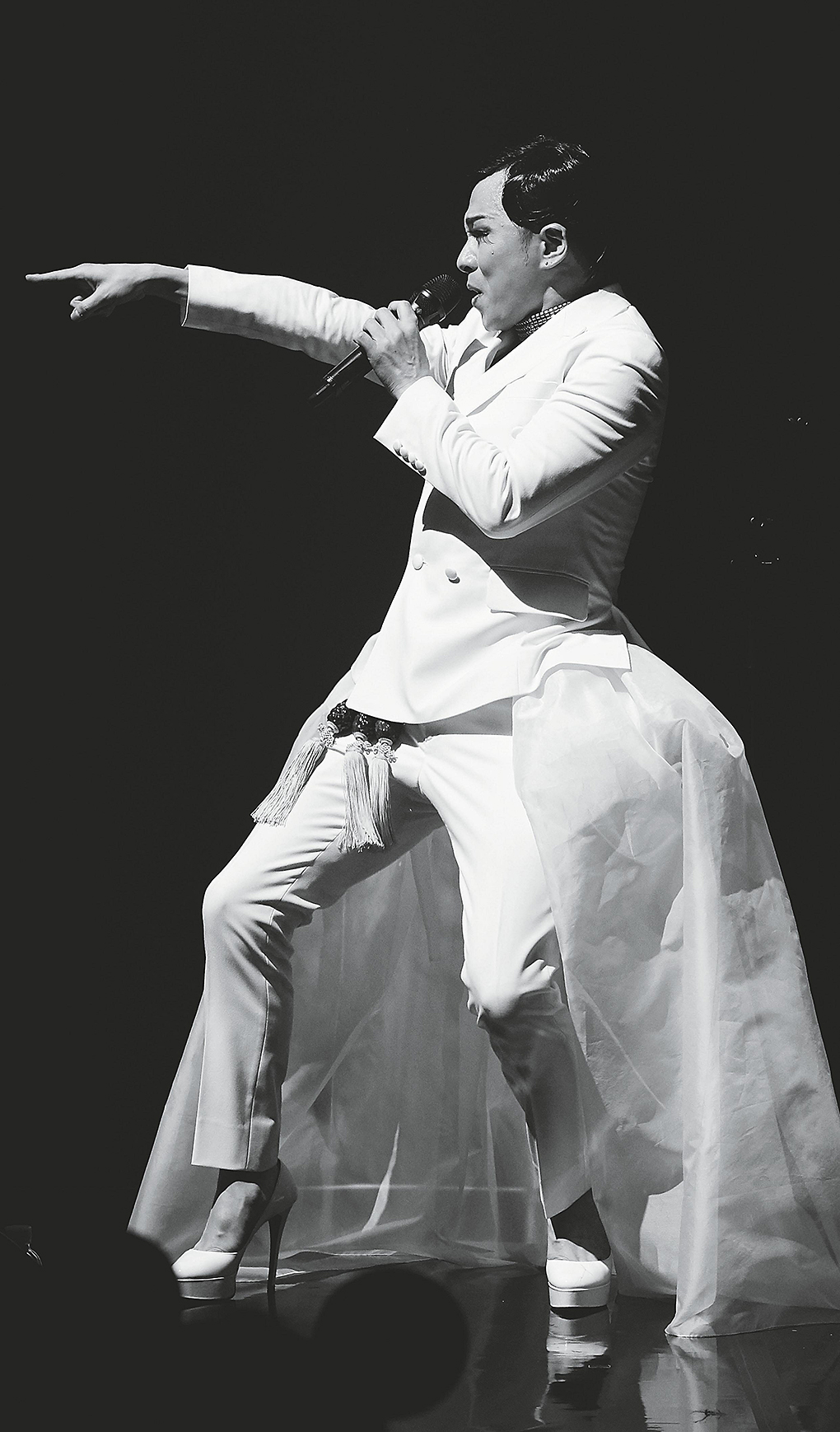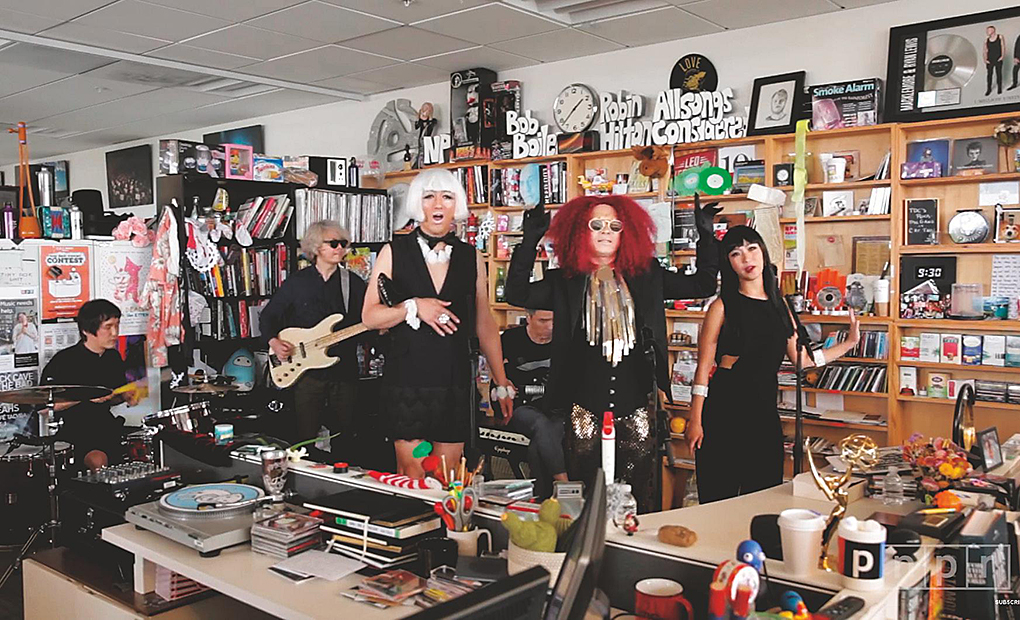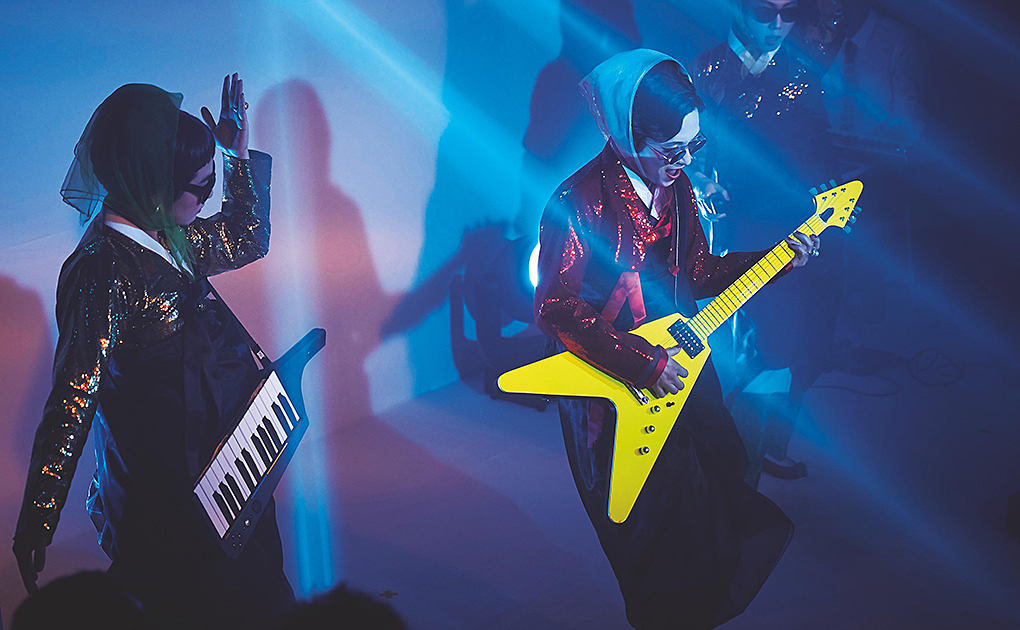Singer Lee Hee-moon delights and surprises audiences with genre-bendingperformances that tap into his native Korean folk music roots. Once calleda “heretic” in the gugak (traditional Korean music) community, he is nowan icon of funky fusion music.

Lee Hee-moonperforms at the ElgarRoom in London’sRoyal Albert Hall inSeptember 2017.Part of the programfor the 4th K-MusicFestival hosted by theKorean Cultural CenterUK, “Korean Men”was planned by Leeand jazz band Prelude,and their concert alsofeatured NomNom,a duo of traditionalsingers. The highlyacclaimed show, whichpremiered in 2016 atthe National Theater ofKorea, fused Gyeonggiminyo and jazz. / Photograph by Kii Studios Photography & Film; Courtesy of Lee Hee-moon Company
Erudite and entertaining, Tiny Desk Concerts is an eclectic video series of live music hosted by National Public Radio (NPR) in Washington, D.C. and uploaded to YouTube. With performances in hundreds of genres already on file, it was easy to assume there would be no surprises when the Korean band SsingSsing showed up. And then the group’s cross-dressing singers unleashed a mixture of rock, disco and psychedelic music, all based on traditional Korean folk songs. Shocking. Bob Boilen, host of NPR’s “All Songs Considered,” called the performance one of the most memorable Tiny Desk Concerts of all time.
That was in September 2017. At the time, the six-member band was on the road to wider fame. Its gigs in Washington, D.C. also included a concert at the John F. Kennedy Center for the Performing Arts, a venue that has eluded even the most famous entertainers. But in 2019, the band suddenly broke up. On a winter day, lead vocalist Lee Hee-moon, 43, sat down in the Itaewon neighborhood of Seoul, a longtime haunt for tourists, expats and U.S. servicemen, to explain.
Lee was born to sing. His mother, Ko Ju-rang, was a master singer of minyo, or traditional Korean folk songs, and as soon as Lee began to speak, he began to sing. In his teen years, however, Korean and Western pop singers bedazzled him. He wanted to be a singer-dancer. Later, he studied visual arts in Japan, and after returning to Korea, he produced music videos working as an assistant director.It was not until he reached his late 20s that Lee returned to traditional folk songs. He recalls feeling like he was “possessed by a spirit.” It is apparent now that being the unisex lead vocalist of SsingSsing was just one stage of his artistic identity, which continues to morph.
The Band
When I first watched SsingSsing perform, I was reminded of the musical “Hedwig and the Angry Inch.” I wonder where your inspiration came from.
The visual presentation of the band was inspired by the film “Moulin Rouge,” singers like Madonna and Min Hae-kyung, and most of all, by choreographer Ahn Eun-me, whom I’ve known personally for years. Ahn is a pioneer of powerful visuals. In her production of “Princess Bari: This World,” which premiered in 2007, I was cast to sing as the princess. At first, I squirmed at the idea of taking a woman’s role, but I eventually realized that I could be pretty good at it. If you have to force your emotions, it’s mere play-acting, but something in me was expressed spontaneously when I sang in that role.
SsingSsing performed concerts in Korea regardless of the size of the venue or audience. But recording for NPR’s Tiny Desk Concerts must have been somewhat different from other shows. How was it?
Having hardly any knowledge of NPR or the program, we got it done like it was just another gig. We were a little flustered when told to sing to the air while standing at the corner of an office with no monitors or speakers. If we’d known the show would attract huge interest and would last forever on YouTube, we would have tried to do better. When we performed “Hangangsu Taryeong” (Han River Song), I even got the lyrics wrong and improvised them on the spot. But the video came out nice all the same, perhaps because their sound engineer was an expert.
I expected that SsingSsing would grab worldwide attention, following in the footsteps of Psy’s “Gangnam Style,” but then you split up at the height of your popularity. Why?
Each of the six members had a distinct individuality. And that was our strength when we were together, having our own ways on stage and never interfering in what the others were doing. But the same tendency seemed to make it easier for us to go our separate ways, as with any relationship that goes through changes. Now, we’ve all found our own places: Jang Young-gyu, the music director, formed a new band called “Lee Nalchi” to tell his unfinished story of music, and Chu Da-hye and Shin Seung-tae are also working on their own music. And the same is true for me.
How was SsingSsing created?
In 2014, I performed in a concert entitled “Kwae” (Hearty Pleasure), a modern interpretation of gut, the traditional shamanic ritual. Jang Young-gyu, who was the music director for the concert, proposed that we perform minyo at clubs. Soon, we invited guitarist Lee Tae-won, drummer Lee Chul-hee, and singers Shin Seung-tae and Chu Da-hye, and the six of us formed SsingSsing.
My Own Sound

Lee performs at thepremiere of “ProjectNAL” at the GrandPerformance Hall ofthe National IntangibleHeritage Center in May2019. To isolate theessence of his sound,melodic instrumentswere omitted; onlythree percussioninstruments – a janggu(hourglass drum),a Western drum anda modular synthesizer –accompanied him. / Photograph by Kwak Ki-gon; Courtesy of Lee Hee-moon Company
Recently, you’ve been performing concerts under the title “Project NAL” and you also released the album “Obangsingwa” (meaning “along with the deities of the five directions”). You must be very busy. Where do you think you’re headed with your art?
I wanted to test my sound without the label of “somebody from SsingSsing.” So I’ve forced myself to the extreme, appearing on a series of experimental stages. Project NAL features my voice combined with a sound performance that consists of the Korean percussion instrument janggu (hourglass drum), a Western drum and a modular synthesizer. As with SsingSsing, the repertoire consists mostly of Gyeonggi minyo (folk songs from Gyeonggi Province), with the addition of other genres like japga (miscellaneous songs), santaryeong (mountain songs) and hoesimgok (songs of remorse). However, my approach to these songs differs from the one I took when singing for SsingSsing.
How is the visual direction of Project NAL different from that of SsingSsing?
I adopted the image of a new bride, representing my rebirth after leaving the world of SsingSsing. I wear a white men’s suit with a white skirt attached to the back, with exquisite bridal makeup on my face.
Let me bring you back in time. How did you start singing minyo?
When I was still working in the field of music video production, I accompanied my mother to a minyo concert where I couldn’t help myself and sang along. Master singer Lee Chun-hee, my mother’s friend, was with us and she must have listened attentively to my singing and humming. A few days later, without my mother’s knowledge, she called and cautiously asked me if I would like to sing professionally. My mother didn’t want her son to become an artist in traditional music because she knew better than anyone how hard the path would be. Master Lee hesitated before calling me because she knew all too well how my mother would feel. I started to learn from her and then went to college to major in traditional Korean music in my late 20s. Most traditional singers called “sorikkun” begin their formal training as children, so I got into this career quite late.
Even before you joined SsingSsing as lead vocalist, you were known as a certified trainee in Gyeonggi minyo, which is Korea’s Intangible Cultural Property No. 57. What about minyo was so enticing to you that you changed the course of your life at that relatively late age?
Gyeonggi minyo is characterized by its cheerful mood and lilting melodies. It employs a lot of vocal techniques. The songs are merry and exciting but they somehow make you feel sad and tearful. Let me take the lyrics of “Cheongchunga” (The Song of Youth) as an example: “Time flows like the river, and a man gets old like the wind.” Singing these plaintive songs with a gleeful dance fills you with complicated thoughts, and it’s like black comedy.This is the difference between Gyeonggi minyo and namdo sori, or folk songs from the southern provinces. Pansori (narrative song) is mostly in minor keys (gyemyeonjo), overflowing with sorrows and lamentations. In contrast, Gyeonggi minyo expresses sadness more cheerfully than mournfully. Someone who posted a comment on a YouTube clip of my performance asked, “Why are my eyes filled with tears listening to this cheerful music?” This is an inherent quality of Gyeonggi minyo and that person instinctively recognized it.
Do you ever get emotional while performing on stage?
When the Project NAL concert premiered at the National Intangible Heritage Center in Jeonju in May 2019, we asked all 250 members of the audience to sit on the stage in order for them to better enjoy the sound. The last song of the repertoire was “Odolttogi,”a folk song from Jeju Island, and I was filled with indescribable feelings singing the refrains together with all of these clapping people sitting so close to me. This was a reinterpreted version of the original folk song which I’d written much earlier but had no opportunity to perform with SsingSsing before it disbanded.
Tearful Mirth
On stage, it looks as if you turn into a shaman or a kind of spiritual being. Have you ever fallen into a trance while performing?
Sometimes, it feels like I’m not the one who’s doing it. The audience gives me energy. I absorb it and return it to them through my performance, and I’m completely exhausted after the show is over. Recently, when I was performing at Senggi Studio in the Hongdae area, the place was so packed with people. It might have reduced the oxygen level and I actually felt out of breath. At the end of the concert, I expressed that feeling through a performance of fainting.
I’m curious to know what kind of music or performances you’ll be putting out into the world in the future.
Throughout this year, I’ll carry on with the “Ego Project,” a series of extemporaneous concerts combining jazz and minyo. I’ll also devote some time to the preliminary work for the production of a musical monodrama. Recently, I came across a book entitled “The Birth of Gangnam” which intrigued me to consider dramatizing it. I myself grew up in Gangnam, so I could create a relevant story – maybe about a young man raised in this stylish, modern area who becomes a minyo singer. More than anything, it would be an interesting project for me.

SsingSsing performsfor NPR’s Tiny DeskConcerts in Washington,D.C. in September 2017.The mix of glam-rockand Gyeonggi minyogenerated wide interest.The members are: fromleft in the back,Lee Chul-hee (drummer),Jang Young-gyu (musicdirector and bassguitarist) andLee Tae-won (guitarist);at front, Shin Seung-tae,Lee Hee-moon andChu Da-hye. / Captured from a Youtube video of NPR Music

Lee Hee-moonCompany presents“Minyo Samcheolli” (FolkSongs from Every Cornerof Korea) at Space Seoro,a small theater in Ogindong, Seoul, in May 2018.Exploring the theme offemale traditional singersof modern times, theshow is the final projectof the “Deep LoveTrilogy,” produced by Leefrom 2016 to 2019. Lee isthe guitarist on the right. / Photograph by Lee Jin-hwan; Courtesy of Lee Hee-moon Compan